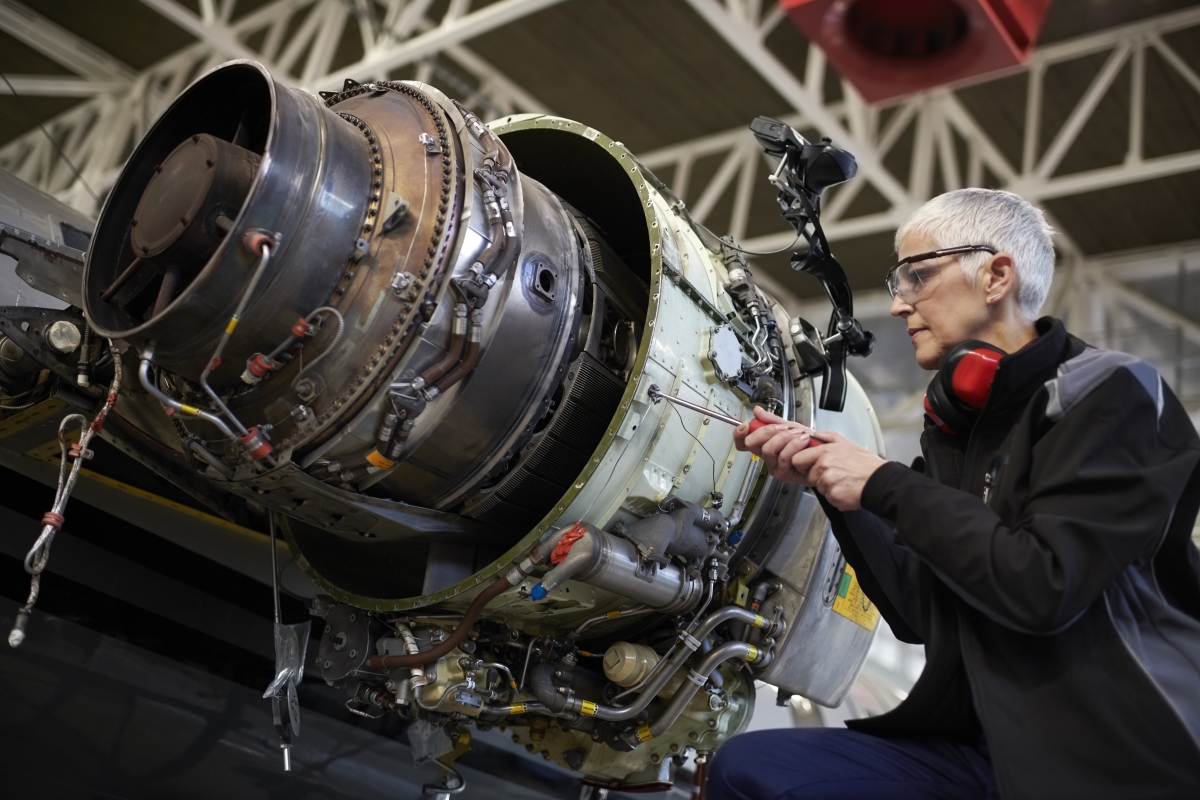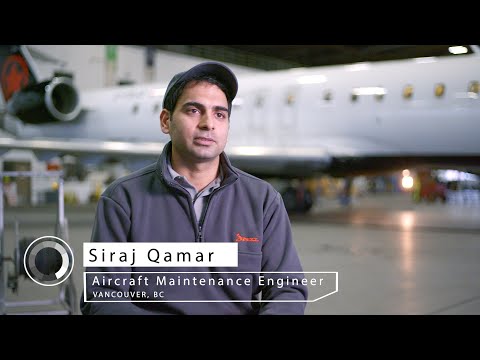Career Overview
Aircraft mechanics:
- Maintain, repair, overhaul, modify and test aircraft structural and mechanical and hydraulic systems
Aircraft inspectors:
- Inspect aircraft and aircraft systems following manufacture, modification, maintenance, repair or overhaul
Aircraft mechanics and aircraft inspectors:
- Work for aircraft manufacturing, maintenance, repair and overhaul establishments
- Also work for airlines, the armed forces and other aircraft operators
Job Titles
Duties
Aircraft mechanics:
- Troubleshoot aircraft structural, mechanical or hydraulic systems to identify problems and adjust and repair systems according to specifications, technical drawings, manuals and established procedures
- Repair and overhaul aircraft structural, mechanical or hydraulic systems
- Install or modify aircraft engines and mechanical, hydraulic, flight control, fuel and pneumatic systems
- Dismantle airframes, aircraft engines or other aircraft systems for repair, overhaul and cleaning, and reassemble
- Perform and document routine maintenance
- Order and maintain inventory of parts and supplies
Aircraft inspectors:
- Inspect structural and mechanical systems of aircraft and make sure they meet Transport Canada and company standards of performance and safety
- Inspect work of aircraft mechanics performing maintenance, repair and overhaul, or modification of aircraft and aircraft mechanical systems to make sure standards and procedures are met
- Maintain detailed repair, inspection and certification records and reports
Special duties
Aircraft mechanics usually specialize in working on:
- Specific aircraft systems such as engines, engine accessories, airframes, propellers, mechanical components or hydraulic systems
- Specific kinds of aircraft, such as light aircraft, jet transports and helicopters
Earnings
Earnings is income that workers receive in exchange for their labour. Depending on the type of employment, earnings can be in the form of wages (hourly), salaries (fixed monthly or annual) or self-employed earnings.
Work Environment
# Workers Employed
2,805% Employed Full Time
70%Key aspects of the work in this occupation:
- Work takes place in a controlled indoor environment.
- Working with equipment, machinery or power/hand tools may be a source of injury.
- Work may produce enough noise to cause marked distraction or possible loss of hearing.
Career Pathways
With experience, aircraft inspectors may progress to shop inspector or supervisor.
AME licences are issued in the following categories:
- M Small and Large Aircraft
- E Electronic Systems
- S Aircraft Structures
Aircraft mechanics may progress to foreman/woman, shop supervisor or aircraft inspector.
Aircraft mechanics and inspectors may acquire further endorsements to their AME licence allowing them to inspect and certify a broader range of aircraft and aircraft systems.
Occupational Interests
It’s important to understand what kinds of occupations align with your interests.
For more about occupational interests visit Skills for the Future Workforce > Characteristics.
Here are the top occupational interest(s) for this career profile:
Education, Training and Skills
- Completion of secondary school is required.
- A college diploma in aircraft maintenance, or
- Completion of a four-year apprenticeship program is usually required.
- Several years of on-the-job training are required for aircraft mechanics.
- Aircraft mechanics and inspectors who sign maintenance releases and certify airworthiness require an Aircraft Maintenance Engineer's (AME) licence issued by Transport Canada.
- Trade certification for aircraft maintenance engineers is available, but voluntary, in Ontario, the Northwest Territories and Nunavut.
- Trade certification for aircraft structural technicians is available, but voluntary, in British Columbia.
- Industry certification from the Canadian Aviation Maintenance Council for some occupations in this unit group is available, but voluntary.
- Aircraft inspectors require several years of experience as an aircraft mechanic.
For more information please see SkilledTradesBC's website at https://skilledtradesbc.ca.
Trades training resources
Visit our trades training page at www.workbc.ca/trades to learn about apprenticeship and trades training in B.C.
Education programs in B.C.

Top Skills
Every job calls for a certain set of skills. Knowing those skills is the first step in finding a good career fit.
Here, you will find the 10 most relevant workplace skills. Some are more important to achieving success in a certain career than others. These skills may come naturally to you or you may need to gain them through education, training and experience.
See the list of work-related skills below, ranked in order of importance for this career. Check out the list and see if this career matches your skills—take that first step!
Using logic and reasoning to identify the strengths and weaknesses of alternative solutions, conclusions or approaches to problems.
Understanding written sentences and paragraphs in work-related documents.
Talking to others to share information effectively.
Conducting tests and inspections of products, services or processes to evaluate quality or performance.
Watching gauges, dials or other indicators to make sure that a machine is working properly.
Giving full attention to what other people are saying, taking time to understand the points being made, asking questions as appropriate, and not interrupting at inappropriate times.
Keeping track of and assessing your performance, other individuals, or organizations to make improvements or take corrective action.
Being able to solve novel, ill-defined problems in complex, real-world settings.
Determining causes of operating errors and deciding what to do about it.
Communicating effectively in writing as appropriate for the needs of the audience.
Labour Market Statistics
Discover data, facts and information that have been gathered and analyzed. Learn about the characteristics of the economy and labour market in B.C.
Employment
Find out about employment types and trends by region and industry.
Employment
2,805Employment by Region







| Region | Employment | % Employment of this Occupation |
|---|---|---|
| Cariboo | 85 | 3.0% |
| Kootenay | 35 | 1.2% |
| Mainland/Southwest | 1,590 | 56.6% |
| North Coast and Nechako | 60 | 2.1% |
| Northeast | 10 | 0.4% |
| Thompson-Okanagan | 570 | 20.3% |
| Vancouver Island/Coast | 450 | 16.0% |
Labour Market Outlook
The B.C. Labour Market Outlook is a 10-year forecast of the expected supply and demand for labour in the province. It’s usually updated every year. The purpose is to provide British Columbians with the knowledge to make informed decisions on careers, skills training, education and hiring.
Forecasted Job Openings (2025-2035)
1,440Forecasted Job Openings
Forecasted Employment Growth Rate
Composition of Job Openings
Job Openings by Region (2025-2035)







| Region | Job Openings | Avg. Annual Employment Growth |
|---|---|---|
| Cariboo | 30 | -0.2% |
| Kootenay | 20 | 4.1% |
| Mainland/Southwest | 910 | 0.3% |
| North Coast and Nechako | 50 | 1.7% |
| Northeast | Not available | Not available |
| Thompson-Okanagan | 230 | 0.5% |
| Vancouver Island/Coast | 200 | 0.6% |
Industry Highlights
Learn about the opportunities in B.C.'s major industries, including employment trends, earning potential, locations of work and more.
Forecasted Job Openings by Industry
| Industry | Job Openings (2025-2035) |
|---|---|
| Transportation and Warehousing | 1,180 |
| Manufacturing | 130 |
| Public Administration | 50 |
| Repair, Personal and Non-Profit Services | 20 |
| Wholesale Trade | 20 |
Resources
-
Aerospace Industries Association of Canada (AIAC)www.aiac.ca
-
Aerospace Industries Association of Canada (AIAC) Pacificaiacpacific.ca
-
Pacific Aircraft Maintenance Engineers Associationwww.pamea.com








